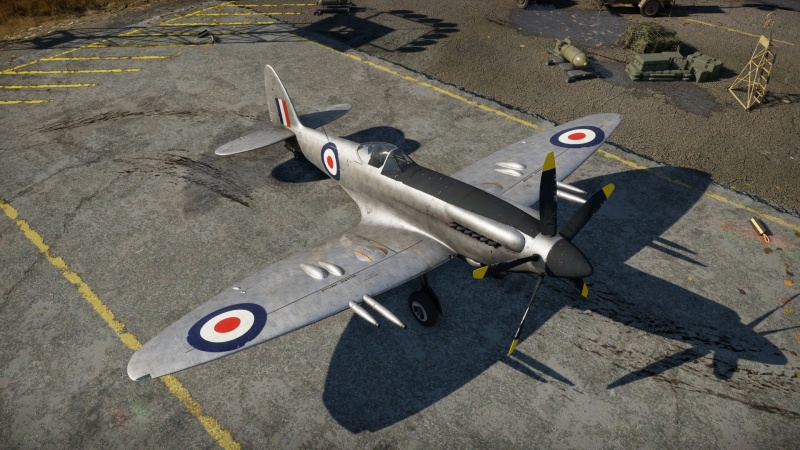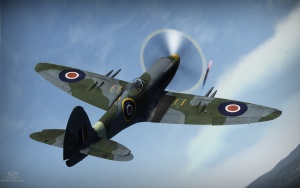Spitfire F Mk 24
| This page is about the British fighter Spitfire F Mk 24. For other versions, see Spitfire (Family). |
Contents
Description
The Spitfire F Mk 24 was the last production model of the famous Supermarine Spitfire. A total of 54 Mk 24 were manufactured, with 27 rebuilt from Mk 22 models. The Mk 24 was largely similar to the previous Mk 22, with the exception of having two rear fuselage fuel tanks installed as well as different rocket mountings allowing for installation of up to eight RP-3 rockets as opposed to six on the Mk 22. The main armament also differed, as some later production Mk 24s were armed with four 20 mm Hispano Mk.V cannons as opposed to Mk.II on the Spitfire Mk 22 or early and reserve variants of the Mk 24. The in-game model is a recreation of VN318, which was armed with Mk.II cannons.
The Spitfire F Mk 24 was introduced in Update 1.39. It is the pinnacle of piston-powered aircraft, one of the first superprops. The playstyle of Mk 24 is very similar to the previous Griffon-powered Spitfires, with the exception of different armament as the Mk 24 is armed with four 20 mm Hispano cannons. Early jet aircraft that pilots may come across are at a severe disadvantage when encountering the Spitfire, as it can out-turn and also catch the majority of these in a dive. The Mk 24 also possesses higher engine power due to the usage of 150 octane fuel, which is unavailable for the previous Mk 22.
General info
Flight performance
| Characteristics | Max Speed (km/h at 8,232 m) |
Max altitude (metres) |
Turn time (seconds) |
Rate of climb (metres/second) |
Take-off run (metres) | |||
|---|---|---|---|---|---|---|---|---|
| AB | RB | AB | RB | AB | RB | |||
| Stock | 721 | 699 | 19.4 | 20.2 | 19.8 | 19.8 | 420 | |
| Upgraded | 837 | 778 | 17.2 | 17.6 | 39.4 | 28.3 | ||
Details
| Features | ||||
|---|---|---|---|---|
| Combat flaps | Take-off flaps | Landing flaps | Air brakes | Arrestor gear |
| X | X | ✓ | X | X |
| Limits | ||||||
|---|---|---|---|---|---|---|
| Wings (km/h) | Gear (km/h) | Flaps (km/h) | Max Static G | |||
| Combat | Take-off | Landing | + | - | ||
| N/A | N/A | 260 | ~11 | ~6 | ||
| Optimal velocities (km/h) | |||
|---|---|---|---|
| Ailerons | Rudder | Elevators | Radiator |
| < 482 | < 400 | < 400 | > 500 |
| Compressor (RB/SB) | ||
|---|---|---|
| Setting 1 | ||
| Optimal altitude | 100% Engine power | WEP Engine power |
| 4,600 m | 1,510 hp | 2,190 hp |
| Setting 2 | ||
| Optimal altitude | 100% Engine power | WEP Engine power |
| 8,600 m | 1,360 hp | 1,993 hp |
Survivability and armour
- 3 mm Steel - Armour plating ammo cover (both wings)
- 6 mm Steel - Upper prop hub plate
- 12.7 mm Steel - Fore cockpit armour plate
- 4 mm Steel - Pilot's seat
- 7 mm Steel - Behind pilot's seat
- 4 mm Steel - Pilot's headrest
- 42.8 mm Bulletproof glass - Armoured windscreen
Modifications and economy
The Spitfire F Mk 24's performance relies on its engine and that should thus be the focus of research. It is recommended you progress through your research in the following order:
- Radiator
- Compressor
- Airframe
- Offensive 20 mm
- Engine
- Engine injection
- 150 octane fuel
- Wings repair
- Cover
- Fuselage Repair
After you have researched all of the above, complete the remaining research in any order. The Offensive 20 mm upgrade is incredibly useful due to the power of the "Air targets" belt on Hispano Mk.II cannons, which is why it is prioritized over the Engine upgrades even with the focus on engine-related upgrades.
Armaments
Offensive armament
The Spitfire F Mk 24 is armed with:
- 4 x 20 mm Hispano Mk.II cannons, wing-mounted (175 rpg inner + 150 rpg outer = 650 total)
Suspended armament
| Default weapon presets | |
|---|---|
| |
Usage in battles
The Spitfire F Mk 24 is an outstanding plane in realistic battles with few weaknesses, meaning the enemy will have a really hard time either catching the Mk 24 or shaking it off of their tail, and only the most skilled of opponents will stand a chance.
It is very important to monitor your energy state, as the Spitfire F Mk 24 is a relatively large fighter aircraft and will be a big target at low speeds.
The main task for a Mk 24 pilot is to utilize the immense power of the Rolls-Royce Griffon engine, which allows the Spitfire to climb at an insanely high rate. The pilot should always use his climb rate to his advantage in combat, using his altitude to dictate the terms of an engagement. Target altitude should usually be around 5-6 km on smaller maps and 6-7 km on larger maps such as Norway or Spain where the Griffon engine will perform optimally.
The Spitfire F Mk 24's main combat tactic is Boom & Zooming due to its outstanding speed, armament, and engine output. Because of the last point, Energy fighting is an option open to the Mk 24 as well, when engaging an enemy separated from his team. The Rolls-Royce Griffon engine is what opens the Spitfire F Mk 24 to both of these tactics. Not only does the Griffon engine bestow the Mk 24 with incredible top speed, but it also causes the fighter to accelerate incredibly fast allowing it to keep its speed for longer even in a sharp climb.
Although boom-and-zooming and energy fighting are the main tactics of the Spitfire F Mk 24, the fighter is also able to keep up with most enemies in-turn fights with few exceptions (namely Japanese fighters). Try to maintain a speed of between 400-500 km/h; this is where the plane maintains a high turn rate. Turning below this velocity against planes such as the P-51H-5-NA is not recommended. The Mk 24 should avoid combat at low altitude especially versus Soviet fighters who excel below 4 km. The Mk 24's strength is at high altitude combat, where it can fully utilize the power of its Griffon engine to excel in combat.
Manual Engine Control
| MEC elements | ||||||
|---|---|---|---|---|---|---|
| Mixer | Pitch | Radiator | Supercharger | Turbocharger | ||
| Oil | Water | Type | ||||
| Not controllable | Controllable Auto control available |
Not controllable Not auto controlled |
Controllable Auto control available |
Combined | Controllable 2 gears |
Not controllable |
Pros and cons
Pros:
- Powerful engine which provides incredible climb rate, good acceleration and top speed
- Equipped with 4 x 20 mm Hispano Mk.II cannons, which are highly powerful and have a high rate of fire
- Incredible at energy fighting
- Performs extremely well at medium to high altitudes
- Excellent acceleration in a dive
- High turn rate at medium speeds
- Is an excellent vehicle to go against jets with
- Very good roll rate
- Very high wing rip speed
- Works well with manual engine control
- High climb rate
Cons:
- Armament is mounted on the wings
- Wings are susceptible to shearing at higher speeds
- WEP causes the plane to consume fuel at a fast rate
- Suffers at lower altitudes where the engine isn't operating at full potential
- Relatively poor low-speed performance
- Mostly faces jets
- Underwing radiators create a large amount of drag, especially when open
History
| Archive of the in-game description | |
|---|---|
|
The Supermarine Spitfire Mk.24 was a single engine, single seat fighter which served with the Royal Air Force during the early post war period. The Mk.24 was the very last land based Spitfire of the long and illustrious line of fighters. It differed only from late production Spitfire Mk.22s in having two extra fuel tanks fitted in the rear fuselage and provisions for under wing rockets. Late versions of the Spitfire Mk.24 were also fitted with the short barrel 20 mm Hispano Mk.V cannon. Only 54 Spitfire Mk.24s were built with a further 27 being converted from Mk.22 airframes. Contra-rotating propellers were tested on the Mk.21, 22 and 24 Spitfires but were still not perfected in time to see service on this last Spitfire variant. The contra-rotating propeller would, however see front line service with the Fleet Air Arm's Seafire Mk.46 and Mk.47. The Spitfire Mk.24 entered service in 1946 with No.80 Squadron in Gutersloh, Germany; the squadron later moved to Hong Kong. In January 1952 the RAF's last front line Spitfire squadron handed its aircraft over to the Hong Kong Auxiliary Air Force, ending a legacy of over 25 years of perhaps the most famous and iconic fighter aircraft in aviation history. | |
Media
- Skins
- Videos
See also
- Related development
External links
| Supermarine | |
|---|---|
| Spitfires | |
| Merlin engine | Spitfire Mk Ia · Spitfire Mk IIa · Spitfire Mk.IIa Venture I · Spitfire Mk IIb |
| Spitfire Mk Vb · Spitfire Mk Vb/trop · Spitfire Mk Vc · Spitfire Mk Vc/trop | |
| Spitfire F Mk IX · Spitfire F Mk IXc · Spitfire F Mk XVI | |
| Spitfire LF Mk IX · Plagis' Spitfire LF Mk IXc | |
| Griffon engine | Spitfire F Mk XIVc · Spitfire F Mk XIVe · Prendergast's Spitfire FR Mk XIVe · Spitfire F Mk XVIIIe · Spitfire F Mk 22 · Spitfire F Mk 24 |
| Export | ▄Spitfire Mk Vb/trop · ▃Spitfire LF Mk IXc · ▂Spitfire Mk IXc · Spitfire Mk IXc · Spitfire Mk.IX (CW) · Weizman's Spitfire LF Mk.IXe · ▄Spitfire FR Mk XIVe |
| Seafires | Seafire LF Mk.III · Seafire F Mk XVII · Seafire FR 47 |
| Export | ▄Seafire LF Mk.III |
| Jet fighters | Attacker FB 1 · Attacker FB.2 · Scimitar F Mk.1 · Swift F.1 · Swift F.7 |
| Hydroplanes | Walrus Mk.I |






